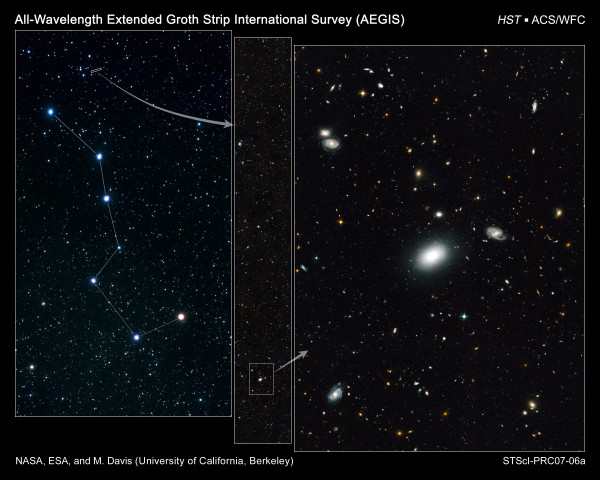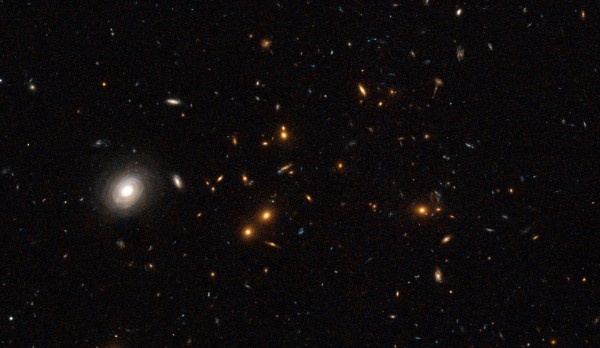“From our home on the Earth, we look out into the distances are strive to imagine the sort of world into which we are born.. But with increasing distance our knowledge fades, and fades rapidly, until at the last dim horizon we search among ghostly errors of observations for landmarks that are scarcely more substantial. The search will continue. The urge is older than history. It is not satisfied and it will not be suppressed.” -Edwin Hubble
The deeper we look out into the Universe, the farther back in time we look. Our largest, deepest surveys have shown us not only galaxies in the very distant Universe, but teach us what they looked like when it was much younger, as well as how clustering -- due mostly to dark matter -- has evolved.
 Image credit: NASA, ESA, M. Davis (University of California, Berkeley), S. Faber (University of California, Santa Cruz), and A. Koekemoer (STScI).
Image credit: NASA, ESA, M. Davis (University of California, Berkeley), S. Faber (University of California, Santa Cruz), and A. Koekemoer (STScI).
The Extended Groth Strip, pictured above, takes up just a sixth of a square degree on the sky, but contains over 50,000 galaxies, giving us a literal treasure trove of riches about the Universe.
Come see all we've learned -- in pictures and no more than 200 words -- on Mostly Mute Monday!


It would be really neat to see the galaxies sorted and grouped by age.
Personally, I would like to compare the real position of these objects to their observed positions to get an idea of their real motion.
@PJ #2: How? Unless you're an omniscient sky dweller, how do you know what their "real position" is?
If astronomers are clever enough to work out that M31 is headed our way (conversely, we are headed in its direction), and most other galaxies are moving away from MW, I would have thought by now, there would be a way of working out galactic motion at least in our own neck of the universe.
Every 50 years we have a new epoch of the position of the stars, epoch 2000 being the current set. We are now 15 years into this one. The exact position of the stars can be worked out. Do we not have a method of working out where other bodies are in relation to our current position in space?
A mental exercise:
I would imagine if one were capable of travelling toward a galaxy in short time, my path to it would not be a straight line, rather curved, since heading toward it, time would be progressing forward until I reached the object. At this point, time would be the present (local) time. The curved path, I feel, would be from the difference between its observed position (before I left earth), to its position on my arrival (in current time). Along the path, light from the object is taking less time to reach me. The expansion of the universe and any local shifting during that time would also account for the curving of the path.
Just a thought. :)
@ Michael & PJ
If by "real position" PJ thinks of a 3D model that shows "depth" as well, instead of an image where it seems that all those galaxies are lying in one plain... then that is certainly doable and has been done for hubble's ultradeep field.
Precise redshifts are measured for each individual galaxy and thus is obtained a 3rd dimension.
http://hubblesite.org/explore_astronomy/deep_astronomy/episodes/4
p.s.
for actual motions of galaxies (other than just saying moving towards us or away), I assume one would need decades if not centuries of observation to notice any sideways motion and have enough plotting points to be able to get trajectories
Yes, indeed 3D. The referenced article I have read recently, and thank you for the re-reference. It is this article which spurned the thought of where all these objects really are now, compared to where we see them where they were. My example with Andromeda above tells me its proximity, and path have been worked out for an encounter in the future. Perhaps a better question is 'is it possible to extrapolate the current position of galactica of a similar distance of M31 to find their real position relative to us' ?
@ PJ
I think something like that is in the works if it's not been done already in the meantime. We have SDSS (sloan's digital sky survey)... which maps the whole sky... so you have X and Y coordinate. Other missions are mapping the spectra and z shifts for nearby and far away galaxies... which gives you a Z coordinate.. so in reality the data is available.. just need some CPU time to plot everything in 3d and render
p.s.
it has been done... and 6 years ago even :D man does time fly
https://www.youtube.com/watch?v=_pDZW-RAXcc
I'm sure you can find better renders with some googling... but the fact is that video is showing actual mapped galaxies with actual positions in 3d space..
PJ #7:
You ask "where all these objects really are now" - they really are where we see them. There isn't some special reference location where the time required for light to travel doesn't exist. But maybe you'd like to see where everything would be if we could go there at Warp 1?
A map like that would allow targeting a laser to hit those galaxies, in time. It's probably classified info since we don't want people to start an intergalactic war...
"You ask “where all these objects really are now” – they really are where we see them."
No they aren't. In the time it took the light to get to us, they moved on.
@ SL #8 & #9
Thanks Sinisa, I appreciate your time. :)